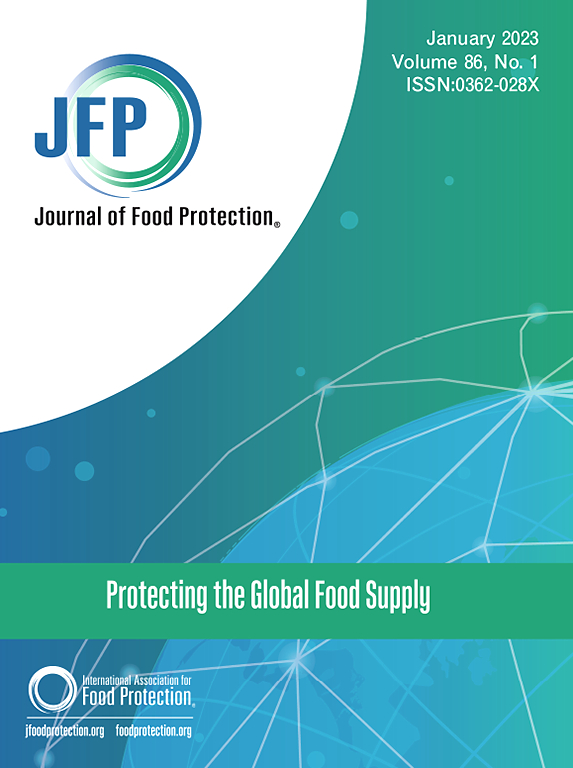The Impact of Subinhibitory Concentrations of Ɛ-polylysine, Hydrogen Peroxide, and Lauric Arginate on Listeria monocytogenes Virulence
IF 2.1
4区 农林科学
Q3 BIOTECHNOLOGY & APPLIED MICROBIOLOGY
引用次数: 0
Abstract
Recent studies on the use of plant-derived and other bioactive compounds and antimicrobials in food have challenged the idea that exposure to antimicrobials at sublethal or subinhibitory concentrations (SICs) increases the virulence potential of bacterial pathogens including Listeria monocytogenes. The objective of this study was to determine the effect of exposure to SICs of Ɛ-polylysine (EPL), hydrogen peroxide (HP), and lauric arginate (LAE) on L. monocytogenes virulence. For all assays, L. monocytogenes strains Scott A and 2014L-6025 were grown to mid-log phase in the presence of SICs of EPL, HP, or LAE. Motility was determined by spot inoculating cultures on soft brain heart infusion agar (0.3% agar). Cultures grown in SICs of antimicrobials were also inoculated onto Caco-2 cells (10:1 MOI) to determine the effects on subsequent adhesion and invasion. Last, the relative expression of key virulence genes (prfA, plcB, hlyA, actA, inlA, inlB, sigB, and virR) following growth in SICs was determined by RT-qPCR. Results indicate that L. monocytogenes growth in the presence of SICs of EPL, HP, or LAE did not affect the motility, adhesion, or invasion capacity of either strain. Changes in gene expression were observed for both L. monocytogenes strains. More specifically, SICs of EPL and LAE reduced hlyA expression in Scott A, whereas SICs of EPL and HP increased the expression of virR. The upregulation of sigB and actA in the presence of EPL and LAE, respectively, was observed in strain 2014L-6025. These findings indicate that exposure to SICs of these antimicrobials has varying effects on L. monocytogenes that differ by strain. Although no phenotypic effects were observed in terms of motility, adhesion, and invasion, the observed changes in virulence gene expression warrant further investigation.
亚抑制浓度的Ɛ-聚赖氨酸、过氧化氢和月桂精氨酸对单核细胞增生李斯特菌毒力的影响。
最近关于在食品中使用植物提取物和其他生物活性化合物及抗菌剂的研究对以下观点提出了质疑,即暴露于亚致死浓度或亚抑制浓度(SIC)的抗菌剂会增加细菌病原体(包括单核细胞增生李斯特菌)的毒性潜力。本研究的目的是确定接触Ɛ-聚赖氨酸(EPL)、过氧化氢(HP)和月桂精氨酸(LAE)的 SIC 对单核细胞增生李斯特菌毒力的影响。在所有试验中,单核细胞增多性酵母菌斯科特 A 株和 2014L-6025 株都在 EPL、HP 或 LAE 的 SIC 存在下生长到菌体中期。通过在软脑心输液琼脂(0.3% 琼脂)上点接种培养物来测定其运动能力。还将在抗菌剂 SICs 中生长的培养物接种到 Caco-2 细胞上(10:1 MOI),以确定其对后续粘附和侵袭的影响。最后,通过 RT-qPCR 测定了关键毒力基因(prfA、plcB、hlyA、actA、inlA、inlB、sigB 和 virR)在 SIC 中生长后的相对表达量。结果表明,单核细胞增多性乳酸杆菌在 EPL、HP 或 LAE 的 SIC 中生长不会影响这两种菌株的运动、粘附或侵袭能力。两种单核细胞增多性酵母菌株的基因表达都发生了变化。更具体地说,在斯科特 A 中,EPL 和 LAE 的 SIC 减少了 hlyA 的表达,而 EPL 和 HP 的 SIC 则增加了 virR 的表达。在 2014L-6025 菌株中观察到,在 EPL 和 LAE 的存在下,sigB 和 actA 分别上调。这些发现表明,暴露于这些抗菌剂的 SICs 会对单核细胞增多性乳酸杆菌产生不同的影响,不同菌株的影响也不同。虽然在运动性、粘附性和侵袭性方面没有观察到表型效应,但观察到的毒力基因表达变化值得进一步研究。
本文章由计算机程序翻译,如有差异,请以英文原文为准。
求助全文
约1分钟内获得全文
求助全文
来源期刊

Journal of food protection
工程技术-生物工程与应用微生物
CiteScore
4.20
自引率
5.00%
发文量
296
审稿时长
2.5 months
期刊介绍:
The Journal of Food Protection® (JFP) is an international, monthly scientific journal in the English language published by the International Association for Food Protection (IAFP). JFP publishes research and review articles on all aspects of food protection and safety. Major emphases of JFP are placed on studies dealing with:
Tracking, detecting (including traditional, molecular, and real-time), inactivating, and controlling food-related hazards, including microorganisms (including antibiotic resistance), microbial (mycotoxins, seafood toxins) and non-microbial toxins (heavy metals, pesticides, veterinary drug residues, migrants from food packaging, and processing contaminants), allergens and pests (insects, rodents) in human food, pet food and animal feed throughout the food chain;
Microbiological food quality and traditional/novel methods to assay microbiological food quality;
Prevention of food-related hazards and food spoilage through food preservatives and thermal/non-thermal processes, including process validation;
Food fermentations and food-related probiotics;
Safe food handling practices during pre-harvest, harvest, post-harvest, distribution and consumption, including food safety education for retailers, foodservice, and consumers;
Risk assessments for food-related hazards;
Economic impact of food-related hazards, foodborne illness, food loss, food spoilage, and adulterated foods;
Food fraud, food authentication, food defense, and foodborne disease outbreak investigations.
 求助内容:
求助内容: 应助结果提醒方式:
应助结果提醒方式:


